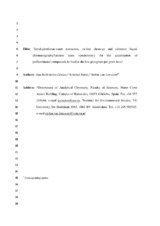Mostrar el registro sencillo del ítem
Tetrahydrofuran–water extraction, in-line clean-up and selective liquid chromatography/tandem mass spectrometry for the quantitation of perfluorinated compounds in food at the low picogram per gram level
| dc.contributor.author | Ballesteros-Gómez, A. | |
| dc.contributor.author | Rubio Bravo, Soledad | |
| dc.contributor.author | Van Leeuwen, Stefan P.J. | |
| dc.date.accessioned | 2023-12-19T09:13:24Z | |
| dc.date.available | 2023-12-19T09:13:24Z | |
| dc.date.issued | 2010 | |
| dc.identifier.uri | http://hdl.handle.net/10396/26385 | |
| dc.description.abstract | A new solvent extraction system was developed for extraction of PFCs from food. The extraction is carried out with 75:25 (v/v) tetrahydrofuran:water, a solvent mixture that provides an appropriate balance of hydrogen bonding, dispersion and dipole–dipole interactions to efficiently extract PFCs with chains containing 4–14 carbon atoms from foods. This mixture provided recoveries above 85% from foods including vegetables, fruits, fish, meat and bread; and above 75% from cheese. Clean-up with a weak anion exchange resin and Envi-carb SPE, which were coupled in line for simplicity, was found to minimize matrix effects (viz. enhancement or suppression of electrospray ionization). The target analytes (PFCs) were resolved on a perfluorooctyl phase column that proved effective in separating mass interferences for perfluorooctane sulfonate (PFOS) in fish and meat samples. The mass spectrometer was operated in the negative electrospray ionization mode and used to record two transitions per analyte and one per mass-labeled method internal standard. The target PFCs were quantified from solvent based calibration curves. The limits of detection (LODs) were as low as 1–5 pg analyte per gram of food; by exception, those for C4 and C5 PFCs were somewhat higher (25–30 pg/g) owing to their less favourable mass response. To the best of our knowledge these are among the best LODs for PFCs in foods reported to date. The analysis of a variety of foods revealed contamination with PFCs at levels from 4.5 to 75 pg/g in 25% of samples (fish and packaged spinach). C10–C14 PFCs were found in fish, which testifies to the need to control long-chain PFCs in this type of food. The proposed method is a useful tool for the development of a large-scale database for the presence of PFCs in foods. | es_ES |
| dc.format.mimetype | application/pdf | es_ES |
| dc.language.iso | eng | es_ES |
| dc.publisher | Elsevier | es_ES |
| dc.rights | https://creativecommons.org/licenses/by-nc-nd/4.0/ | es_ES |
| dc.source | Ballesteros‐Gómez, A., Rubio, S., & Van Leeuwen, S. (2010). Tetrahydrofuran–water extraction, in-line clean-up and selective liquid chromatography/tandem mass spectrometry for the quantitation of perfluorinated compounds in food at the low picogram per gram level. Journal of Chromatography A, 1217(38), 5913-5921. https://doi.org/10.1016/j.chroma.2010.07.032 | es_ES |
| dc.subject | PFAS | es_ES |
| dc.subject | Food | es_ES |
| dc.subject | PFOA | es_ES |
| dc.subject | Human dietary exposure | es_ES |
| dc.subject | Teas plot | es_ES |
| dc.subject | Hildebrand solubility parameter | es_ES |
| dc.title | Tetrahydrofuran–water extraction, in-line clean-up and selective liquid chromatography/tandem mass spectrometry for the quantitation of perfluorinated compounds in food at the low picogram per gram level | es_ES |
| dc.type | info:eu-repo/semantics/article | es_ES |
| dc.relation.publisherversion | https://doi.org/10.1016/j.chroma.2010.07.032 | es_ES |
| dc.relation.projectID | Gobierno de España. CTQ2008-01068 | es_ES |
| dc.relation.projectID | Gobierno de España. AP2005-4275 | es_ES |
| dc.relation.projectID | Unión Europea. PERFOOD-227525 | es_ES |
| dc.rights.accessRights | info:eu-repo/semantics/openAccess | es_ES |

